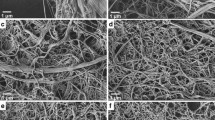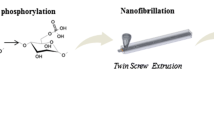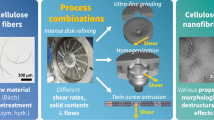Abstract
The twin-screw extrusion (TSE) process has recently been investigated for the production of cellulose nanofibrils (CNF). The main advantage of this process is the production of CNF at high solid content (around 20 wt% suspensions) and lower energy consumption. Typically, studies focus on the quality of the extruded material (i.e., CNF) by comparing different pretreatments, biomass sources or combinations of processes. Limited information is available on the TSE process itself and its stability. This work proposes to analyze some key parameters such as torque, in situ temperature and flow of extruded material. All together they reflect a certain stability of the TSE process. The process is considered stable when the torque and temperatures plateau and when the mass flow is continuous and constant. These parameters vary depending on the different pretreatments and the solid content of the cellulose suspensions introduced in the TSE. Morphologies of extruded CNF are characterized at different scales with optical microscopy, SEM-FEG and TEM images. A simplified quality index was calculated to compare extruded CNF. A high and fluctuating torque, rising temperatures and discontinuous mass flow were recorded for the enzymatically pretreated pulp and refined pulp with a long dwell time of the fibers in the extruder. On the contrary, a low and very stable torque, stabilized temperatures and continuous mass flow were reported for the pulp obtained after a combination of enzymatic hydrolysis and refining.
Graphical abstract









Similar content being viewed by others
Explore related subjects
Discover the latest articles, news and stories from top researchers in related subjects.Data availability
Not applicable.
References
Turbak AF, Snyder FW, Sandberg KR (1983) Microfibrillated cellulose, a new cellulose product: properties, uses, and commercial potential. J Appl Polym Sci Appl Polym Symp 37:815
Rai R, Dhar P (2022) Biomedical engineering aspects of nanocellulose: a review. Nanotechnology 33(36):362001. https://doi.org/10.1088/1361-6528/ac6fef
Dufresne A (2022) Preparation and applications of cellulose nanomaterials. Chem Afr. https://doi.org/10.1007/s42250-022-00542-x
Chen Z et al (2023) Advanced flexible materials from nanocellulose. Adv Funct Mater 33:2214245. https://doi.org/10.1002/adfm.202214245
Dias OAT, Konar S, Leão AL, Yang W, Tjong J, Sain M (2020) Current state of applications of nanocellulose in flexible energy and electronic devices. Front Chem. https://doi.org/10.3389/fchem.2020.00420
Lavoine N, Desloges I, Dufresne A, Bras J (2012) Microfibrillated cellulose – Its barrier properties and applications in cellulosic materials: a review. Carbohyd Polym 90(2):735–764. https://doi.org/10.1016/j.carbpol.2012.05.026
Hubbe MA et al (2017) Nanocellulose in thin films coatings and plies for packaging applications: a review. BioResources. https://doi.org/10.15376/biores.12.1.2143-2233
Kontturi E et al (2018) Advanced materials through assembly of nanocelluloses. Adv Mater 30(24):1703779. https://doi.org/10.1002/adma.201703779
Chen C, Xi Y, Weng Y (2022) Recent Advances in cellulose-based hydrogels for tissue engineering applications. Polymers. https://doi.org/10.3390/polym14163335
Balea A, Fuente E, Blanco A, Negro C (2019) Nanocelluloses: natural-based materials for fiber-reinforced cement composites. A Crit Rev Polym 11(3):518. https://doi.org/10.3390/polym11030518
Szafraniec M, Grabias-Blicharz E, Barnat-Hunek D, Landis EN (2022) A critical review on modification methods of cement composites with nanocellulose and reaction conditions during nanocellulose production. Materials 15(21):7706. https://doi.org/10.3390/ma15217706
Korhonen O, Budtova T (2020) All-cellulose composite aerogels and cryogels. Compos A Appl Sci Manuf 137:106027. https://doi.org/10.1016/j.compositesa.2020.106027
Nargatti KI, Subhedar AR, Ahankari SS, Grace AN, Dufresne A (2022) Nanocellulose-based aerogel electrodes for supercapacitors: a review. Carbohydr Polym 297:120039
Håkansson KMO et al (2016) Solidification of 3D printed nanofibril hydrogels into functional 3D cellulose structures. Adv Mater Technologies 1(7):1600096. https://doi.org/10.1002/admt.201600096
Koppolu R, Banvillet G, Ghimire H, Bras J, Toivakka M (2022) Enzymatically pretreated high-solid-content nanocellulose for a high-throughput coating process. ACS Appl Nano Mater. https://doi.org/10.1021/acsanm.2c02423
Costa C et al (2019) Emulsion formation and stabilization by biomolecules: the leading role of cellulose. Polymers 11(10):1570. https://doi.org/10.3390/polym11101570
Pääkkö M et al (2007) enzymatic hydrolysis combined with mechanical shearing and high-pressure homogenization for nanoscale cellulose fibrils and strong gels. Biomacromol 8(6):1934–1941. https://doi.org/10.1021/bm061215p
Moreau C et al (2019) Lytic polysaccharide monooxygenases (LPMOs) facilitate cellulose nanofibrils production. Biotechnol Biofuels 12:156. https://doi.org/10.1186/s13068-019-1501-0
Isogai A, Saito T, Fukuzumi H (2011) TEMPO-oxidized cellulose nanofibers. Nanoscale 3(1):71–85. https://doi.org/10.1039/c0nr00583e
Gandini A, Belgacem MN (2016) The Surface and in-depth modification of cellulose Fibers. In: Rojas OJ (ed) Cellulose chemistry and properties: fibers, nanocelluloses and advanced materials. Springer Verlag Berlin, Berlin
Rol F, Belgacem MN, Gandini A, Bras J (2019) Recent advances in surface-modified cellulose nanofibrils. Prog Polym Sci 88:241–264. https://doi.org/10.1016/j.progpolymsci.2018.09.002
Hall TD, Inman ME, Snyder ST, Vijapur SH, Taylor EJ, Le TXH, Method and apparatus for electrochemical dewatering of suspensions of cellulosic nanomaterials’, US20200346953A1, Nov. 05, 2020 Accessed: Jul. 04, 2023. [Online]. Available: https://patents.google.com/patent/US20200346953A1/en
Peng Y, Gardner DJ, Han Y (2012) Drying cellulose nanofibrils: in search of a suitable method. Cellulose 19(1):91–102. https://doi.org/10.1007/s10570-011-9630-z
Nordenström M, Kaldéus T, Erlandsson J, Pettersson T, Malmström E, Wågberg L (2021) Redispersion strategies for dried cellulose nanofibrils. ACS Sustain Chem Eng 9(33):11003–11010. https://doi.org/10.1021/acssuschemeng.1c02122
Hiltunen J, Kemppainen K, Pere J Process for producing fibrillated cellulose material, WO2015092146A1, Jun. 25, 2015 Accessed: Jul. 04, 2023. [Online]. Available: https://patents.google.com/patent/WO2015092146A1/en
Rol F et al (2017) Pilot-scale twin screw extrusion and chemical pretreatment as an energy-efficient method for the production of nanofibrillated cellulose at high solid content. ACS Sustain Chem Eng 5(8):6524–6531. https://doi.org/10.1021/acssuschemeng.7b00630
Norizan MN et al (2022) Nanocellulose-based nanocomposites for sustainable applications: a review. Nanomaterials 12(19):3483. https://doi.org/10.3390/nano12193483
Heiskanen I, Harlin A, Backfolk v, Laitinen R Process for production of microfibrillated cellulose in an extruder and microfibrillated cellulose produced according to the process, WO2011051882 (A1), May 05, 2011 Accessed: Sep. 06, 2022. [Online]. Available: https://worldwide.espacenet.com/publicationDetails/biblio?FT=D&date=20110505&DB=&locale=fr_EP&CC=WO&NR=2011051882A1&KC=A1&ND=4
Gatt E, Rigal L, Vandenbossche V (2018) Biomass pretreatment with reactive extrusion using enzymes: a review. Ind Crops Prod 122:329–339. https://doi.org/10.1016/j.indcrop.2018.05.069
Bouvier J, Campanella OH (2014) Extrusion Processing Technology: Food and Non‐Food Biomaterials, 1st ed. Wiley, p.544. https://doi.org/10.1002/9781118541685.
Kargarzadeh H et al (2018) Recent developments in nanocellulose-based biodegradable polymers, thermoplastic polymers, and porous nanocomposites. Prog Polym Sci 87:197–227
Ho TTT, Abe K, Zimmermann T, Yano H (2015) Nanofibrillation of pulp fibers by twin-screw extrusion. Cellulose 22(1):421–433. https://doi.org/10.1007/s10570-014-0518-6
Rol F, Belgacem N, Meyer V, Petit-Conil M, Bras J (2019) Production of fire-retardant phosphorylated cellulose fibrils by twin-screw extrusion with low energy consumption. Cellulose 26(9):5635–5651. https://doi.org/10.1007/s10570-019-02447-4
Rol F, Saini S, Meyer V, Petit-Conil M, Bras J (2019) Production of cationic nanofibrils of cellulose by twin-screw extrusion. Ind Crops Prod 137:81–88. https://doi.org/10.1016/j.indcrop.2019.04.031
Rol F, Vergnes B, El Kissi N, Bras J (2020) Nanocellulose production by twin-screw extrusion: simulation of the screw profile to increase the productivity. ACS Sustain Chem Eng 8(1):50–59. https://doi.org/10.1021/acssuschemeng.9b01913
Khadraoui M, Khiari R, Bergaoui L, Mauret E (2022) Production of lignin-containing cellulose nanofibrils by the combination of different mechanical processes. Ind Crops Prod 183:114991. https://doi.org/10.1016/j.indcrop.2022.114991
Razzak A, Khiari R, Moussaoui Y, Belgacem MN (2022) Cellulose nanofibers from schinus molle: preparation and characterization. Molecules. https://doi.org/10.3390/molecules27196738
Espinosa E, Rol F, Bras J, Rodríguez A (2019) Production of lignocellulose nanofibers from wheat straw by different fibrillation methods. COMPARISON of its viability in cardboard recycling process. J Clean Prod 239:118083. https://doi.org/10.1016/j.jclepro.2019.118083
Espinosa Víctor E, Rol F, Bras J, Rodríguez A (2020) Use of multi-factorial analysis to determine the quality of cellulose nanofibers: effect of nanofibrillation treatment and residual lignin content. Cellulose 27(18):10689–10705. https://doi.org/10.1007/s10570-020-03136-3
Banvillet G et al (2023) Cellulose nanofibril production by the combined use of four mechanical fibrillation processes with different destructuration effects. Cellulose. https://doi.org/10.1007/s10570-022-05016-4
Rol F, Banvillet G, Meyer V, Petit-Conil M, Bras J (2018) Combination of twin-screw extruder and homogenizer to produce high-quality nanofibrillated cellulose with low energy consumption. J Mater Sci 53(17):12604–12615. https://doi.org/10.1007/s10853-018-2414-1
Banvillet G, Gatt E, Belgacem N, Bras J (2021) Cellulose fibers deconstruction by twin-screw extrusion with in situ enzymatic hydrolysis via bioextrusion. Biores Technol 327:124819. https://doi.org/10.1016/j.biortech.2021.124819
Rol F (2019) Cellulose pretreatments for a nanofibrillation by twin-screw extrusion, UGA, Grenoble
Bras J, Rol F, Petit-Conil M, Meyer V Procédé De Fabrication D’une Suspension De Nanofibrilles De Cellulose, WO2020221934A1, Nov. 05, 2020
Desmaisons J, Boutonnet E, Rueff M, Dufresne A, Bras J (2017) A new quality index for benchmarking of different cellulose nanofibrils. Carbohyd Polym 174:318–329. https://doi.org/10.1016/j.carbpol.2017.06.032
Zhang H et al (2023) Size-controlled synthesis of xylan micro / nanoparticles by self-assembly of alkali-extracted xylan. Carbohyd Polym 315:120944. https://doi.org/10.1016/j.carbpol.2023.120944
Wang H et al (2023) Repurposing Xylan biowastes for sustainable household detergents. ACS Sustain Chem Eng 11(7):2949–2958. https://doi.org/10.1021/acssuschemeng.2c06439
Meng Z et al (2021) Bottom-up construction of xylan nanocrystals in dimethyl sulfoxide. Biomacromol. https://doi.org/10.1021/acs.biomac.0c01600
Falcoz-Vigne L et al (2017) Quantification of a tightly adsorbed monolayer of xylan on cellulose surface. Cellulose 24(9):3725–3739. https://doi.org/10.1007/s10570-017-1401-z
Park S, Baker JO, Himmel ME, Parilla PA, Johnson DK (2010) Cellulose crystallinity index: measurement techniques and their impact on interpreting cellulase performance. Biotechnol Biofuels 3(1):10. https://doi.org/10.1186/1754-6834-3-10
French AD (2014) Idealized powder diffraction patterns for cellulose polymorphs. Cellulose 21(2):885–896. https://doi.org/10.1007/s10570-013-0030-4
Wang L, Zhang Y, Gao P, Shi D, Liu H, Gao H (2006) Changes in the structural properties and rate of hydrolysis of cotton fibers during extended enzymatic hydrolysis. Biotechnol Bioeng 93(3):443–456. https://doi.org/10.1002/bit.20730
Gharehkhani S et al (2015) Basic effects of pulp refining on fiber properties—A review. Carbohyd Polym 115:785–803. https://doi.org/10.1016/j.carbpol.2014.08.047
Wang Q et al (2020) Understanding the effect of depth refining on upgrading of dissolving pulp during cellulase treatment. Ind Crops Prod 144:112032. https://doi.org/10.1016/j.indcrop.2019.112032
Hermans PH, Weidinger A (1946) On the recrystallization of amorphous cellulose. J Am Chem Soc 68(12):2547–2552. https://doi.org/10.1021/ja01216a037
Zeng J et al (2021) Cellulose nanofibrils manufactured by various methods with application as paper strength additives. Sci Rep. https://doi.org/10.1038/s41598-021-91420-y
Banvillet G, Industrial application of pretreatments for obtaining high quality cellulose nanofibrils, These de doctorat, Université Grenoble Alpes, 2021. Accessed: Mar. 27, 2024. [Online]. Available: https://theses.fr/2021GRALI032
Kępa K, Chaléat CM, Amiralian N, Batchelor W, Grøndahl L, Martin DJ (2019) Evaluation of properties and specific energy consumption of spinifex-derived lignocellulose fibers produced using different mechanical processes. Cellulose 26(11):6555–6569. https://doi.org/10.1007/s10570-019-02567-x
Rissanen V. Process optimization of cellulose fibril production - the effect of process medium composition on energy efficiency and product quality
Missoum K, Belgacem N, Bras J (2013) Nanofibrillated cellulose surface modification: a review. Materials 6:1745–1766. https://doi.org/10.3390/ma6051745
Acknowledgements
This study is funded by Grenoble INP and Centre technique, du Papier (Grenoble, France). The LGP2 is part of the LabEx Tec 21 (Grant Agreement No. ANR-11-LABX-0030), the Institut Carnot Polynat (Grant Agreement No. ANR-16-CARN-002501) and the Cross disciplinary program Glyco@Alps (Investissements d’avenir – Grant agreement ANR-15-IDEX-02). Authors would like to thank Jean-Luc Puteaux and the NanoBio-ICMG platform (UAR 2607) for granting access to the TEM in CERMAV (Grenoble, France), Thierry Encinas in CMTC for XRD analysis (Grenoble, France) and Novozymes for the enzymes.
Author information
Authors and Affiliations
Corresponding author
Ethics declarations
Conflict of interest
The authors declare that there was no competing financial and conflict of interest which could affect the results of this work.
Ethical approval
Not applicable.
Additional information
Handling Editor: Stephen Eichhorn.
Publisher's Note
Springer Nature remains neutral with regard to jurisdictional claims in published maps and institutional affiliations.
Supplementary Information
Below is the link to the electronic supplementary material.
Rights and permissions
Springer Nature or its licensor (e.g. a society or other partner) holds exclusive rights to this article under a publishing agreement with the author(s) or other rightsholder(s); author self-archiving of the accepted manuscript version of this article is solely governed by the terms of such publishing agreement and applicable law.
About this article
Cite this article
Freville, E., Zeno, E., Meyer, V. et al. Process stability optimization of the twin-screw extrusion adapted for concentrated cellulose fibrillation. J Mater Sci 59, 15904–15919 (2024). https://doi.org/10.1007/s10853-024-10115-7
Received:
Accepted:
Published:
Issue Date:
DOI: https://doi.org/10.1007/s10853-024-10115-7




